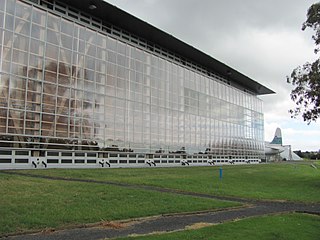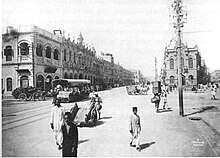
A tram is a railcar that runs on tramway track on public urban streets; some include segments of segregated right-of-way. The lines or networks operated by tramcars as public transport are called tramways or simply tram/streetcar. Many recently built tramways use the contemporary term light rail. Historically the terms electric street railways and trolley were also used in the United States. In the United States, the term tram has sometimes been used for rubber-tired trackless trains, which are unrelated to other kinds of trams.
There have been two separate generations of trams in London, from 1860 to 1952 and from 2000 to the present. There were no trams at all in London between 1952 and 2000.
Trams in India were established in the late-19th century. Horse-drawn trams were introduced in Kolkata in 1873; electric trams began in Chennai in 1895, and trams were also introduced in Mumbai, Kanpur, and Delhi. They were discontinued in all Indian cities between 1933 and 1964, except for Kolkata.

The Museum of Transport and Technology (MOTAT) is a science and technology museum located in Western Springs, Auckland, New Zealand. It is located close to the Western Springs Stadium, Auckland Zoo and the Western Springs Park. The museum has large collections of civilian and military aircraft and other land transport vehicles. An ongoing programme is in place to restore and conserve items in the collections. This work is largely managed by volunteers but, since the passing of the Museum of Transport and Technology Act in 2000, has been supported by full-time professional museum. New public programmes and facilities now promote the collections.

Motor Rail was a British locomotive-building company, originally based in Lewes, Sussex, they moved in 1916 to Bedford. In 1987 loco manufacture ceased, and the business line sold to Alan Keef Ltd of Ross-on-Wye, who continue to provide spares and have built several locomotives to Motor Rail designs.

Nottingham and District Tramways Company Limited was a tramway operator from 1875 to 1897 based in Nottingham in the United Kingdom.
Dick, Kerr and Company was a locomotive and tramcar manufacturer based in Kilmarnock, Scotland and Preston, England.
Trams in Asia were well established at the start of the 20th century, but started to decline in use in the 1930s. By the 1960s, the majority of systems had been closed down. Extensive legacy tramways still exist in Japan. Recently, more modern systems have been built in China.

The history of trams, streetcars, or trolleys began in the early nineteenth century. It can be divided up into several discrete periods defined by the principal means of motive power used.

Glasgow Corporation Tramways were formerly one of the largest urban tramway systems in Europe. Over 1000 municipally-owned trams served the city of Glasgow, Scotland with over 100 route miles by 1922. The system closed in 1962 and was the last city tramway in Great Britain.

Dundee Corporation Tramways formerly served the City of Dundee in Scotland. The Corporation had financed the construction of a horse tramway in 1877, but had then leased it to the Dundee and District Tramways Company. They had replaced most of the horse trams with steam tram locomotives pulling trailer cars from 1884, but in 1897 the Corporation decided that it would run the tramway system itself. After some negotiation and the payment of compensation, they took over the system in 1899, with a view to electrifying it. Electric trams started running in 1900, and the changeover was completed in 1902.

Between 1901 and 1949 Manchester Corporation Tramways was the municipal operator of electric tram services in Manchester, England. At its peak in 1928, the organisation carried 328 million passengers on 953 trams, via 46 routes, along 292 miles (470 km) of track.
Southend-on-Sea Corporation Tramways served the town of Southend-on-Sea in Essex from 19 July 1901 until 8 April 1942.

Sunderland Corporation Tramways operated a tramway service in Sunderland between 1900 and 1954.

Coventry Corporation Tramways operated a tramway service in Coventry, England, between 1912 and 1940.

Dundee and District Tramways operated a tramway service in Dundee between 1877 and 1899.
Llanelly and District Electric Tramways operated a standard gauge tramway service in Llanelli, Wales, between 1908 and 1933. It was the successor to a 3 ft gauge horse tramway, which ran from 1882 until 1908. A complex series of negotiations took place in the early 1900s, resulting in the horse tramway being converted to an electric tramway. Standard gauge horse trams were run initially, until the company completed North Dock power station, which supplied electricity to the tramway. Two of the employees who worked on the construction went on to found Balfour Beatty.
The Tramway Historical Society Inc. is located at the Ferrymead Heritage Park in the Christchurch, New Zealand suburb of Ferrymead and operates the standard gauge Ferrymead Tramway. Trams have operated at Ferrymead since 1968, with progressive extensions built between 1970 and 1984 allowing trams to operate within the boundaries of the Heritage Park. The Society also operates and own a collection of historic trolley buses and diesel buses.

The Tallinn tram network is the only tram network in Estonia. Together with the four-route trolleybus network (et), the four tram lines, with a total length of 19.7 km arranged in a roughly cross-shaped layout, provide a backbone for the public transport network in the Estonian capital. All the routes meet up at Hobujaama in the city centre. Trams are unidirectional, one-sided and single-person operated, and much of the network runs on segregated track.
Bradford Corporation Tramways were a tramway network in the city of Bradford, West Riding of Yorkshire, England which operated trams from 1882 until 1950 and trolleybuses from 1911 until 1972. The track gauge of the tramways was 4 ft.











